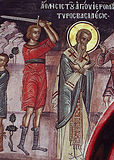

| Previous day | Next day |
| Old Style
April 26
|
Thursday |
New Style
May 9
|
| 2nd Week after Pascha. Tone 1. | No fast.
|
![]() Hieromartyr Basil, bishop of Amasea (ca. 323).
Hieromartyr Basil, bishop of Amasea (ca. 323). ![]() St. Stephen, bishop of Perm (1396).
St. Stephen, bishop of Perm (1396).
Righteous Virgin Glaphyra of Nicomedia (322). St. Ioannicius of Devic (Serbia) (13th c.).
Martyrs Cyril, Chindeu, and Tasie of Axiopolis (ca. 304). Sts. Andrew and Anatole, disciples of St. Euthymius the Great (5th c.). St. Richarius, abbot, in Picardy (645). St. Calantius of Tamassos on Cyprus (8th c.). St. George of Cyprus (1091). New Martyrs of Novo Selo (Bulgaria) (1876).
Repose of Schemanun Agnia (Chizhikov) of Akulovo (1984).
Thoughts for Each Day of the Year
According to the Daily Church Readings from the Word of God
By St. Theophan the Recluse

Thursday. [Acts 4:23–31; John 5:24–30]
And they shall come forth; they that have done good, unto the resurrection of life; and they that have done evil, unto the resurrection of damnation (John 5:29). This is how everything ends! As each river flows into its own sea, so the flow of each of our lives comes, at last, to a place according to its nature. Those who will be resurrected unto life will also be at the judgment; but the judgment will only seal their justification, and determine their life, while the others will be resurrected only to hear the condemnation of eternal death. Their life and death are characterized even now—because some do living deeds, while others do dead and deadening deeds. Living deeds are those which are done according to the commandments, with joy of the spirit, unto the glory of God; dead deeds are those which are done in opposition to the commandments with forgetfulness of God, to please oneself and one’s passions. Dead deeds are all which although in form may not oppose the commandments, are done without any thought about God and eternal salvation, according to some aspect of self-love. God is life; only what contains part of Him is alive. And so whoever has only dead and deadening deeds is bound directly for death, and on the last day will come out into the condemnation of death; but whoever has all living deeds is bound for eternal life, and on the last day will come and receive it.
Articles
 Hieromartyr Basil the Bishop of AmaseaThe Hieromartyr Basil, Bishop of Amasea, lived at the beginning of the fourth century in the Pontine city of Amasea. |
 St. Stephen the Bishop of PermSaint Stephen the Enlightener of Perm, and Apostle to the Zyrians, was born around the year 1340 into the family of Simeon, a cleric of the Ustiug cathedral. |
 Righteous Virginmartyr GlaphyraLicinius burned with passion for Glaphyra, a maidservant of his wife Constantia.The holy virgin reported this to the empress and sought her help. |

